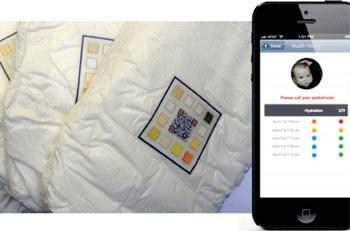Diapers with Test Strips Help Spot Developing Disease
By HospiMedica International staff writers
Posted on 25 Jul 2013
Sophisticated diapers with built-in test strips could alert to medical conditions that require immediate attention.Posted on 25 Jul 2013
Smart diapers are an unobtrusive method of tracking a child’s health via home urinalysis. As the child urinates, the liquid makes contact with a square QR code that has test strips surrounding it; there is also a neutral white square, to more easily check for color changes in the other squares. Once the colors have settled, a picture is taken of the strips and QR code. A complimentary smartphone app automatically recognizes the colors and their location relative to the code, and provides output on any potential medical conditions, including urinary tract infections, prolonged dehydration, or signs of kidney problems.

Image: Smart diapers and the accompanying app (Photo courtesy of Pixie Scientific).
All these conditions that often affect babies can be detected through the use of urine test strips, but such strips are cumbersome to use, especially with babies, who do not urinate on command. By using the Smart diaper, parents do not have wait for the child to pee, or go through the unpleasant task of squeezing urine drops out of soiled diapers onto test strips. The diapers can also help parents track a sick child's health for months or years, automatically looking for emerging trends.
The test pad area contains reagents that interact with leukocytes and nitrites generated by bacteria. The reagents and the dyes formed as a result of reaction with urine content are not toxic and never come in direct contact with the child’s skin, since they are positioned over the absorbent core and the inner layer of the diaper, which does not let liquid back in. The Smart Diaper is under development by Pixie Scientific (New York, NY, USA), and is expected to be tested at Benioff Children’s Hospital (San Francisco, CA, USA) in September 2013.
“I was driving with my wife and daughter one day, when my wife asked if the baby had wet herself; I realized she was sitting in data,” said Yaroslav Faybishenko, Pixie’s founder. “We could use special engineered diapers and require data before the visible symptoms set in and to try to understand the onset of any chronic conditions before simply before the symptoms are visible.”
Related Links:
Pixie Scientific
Benioff Children’s Hospital














